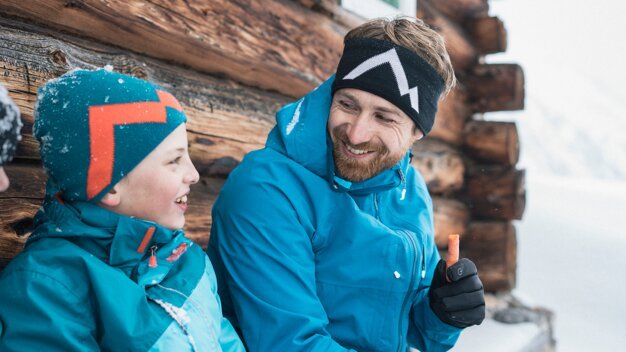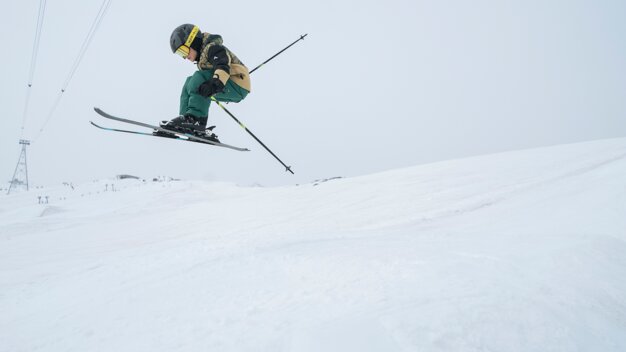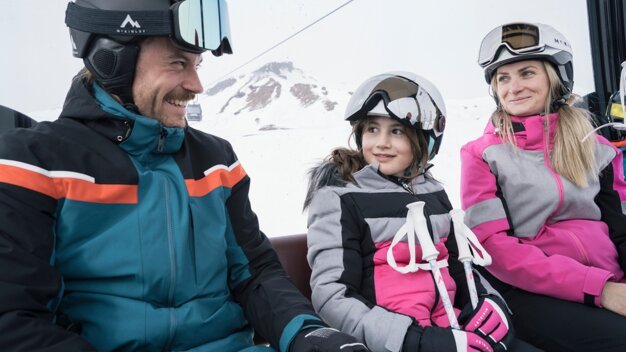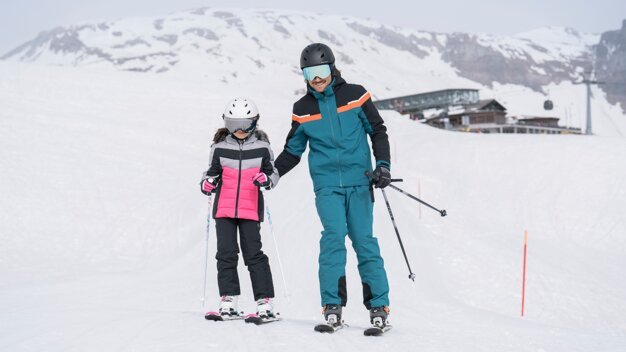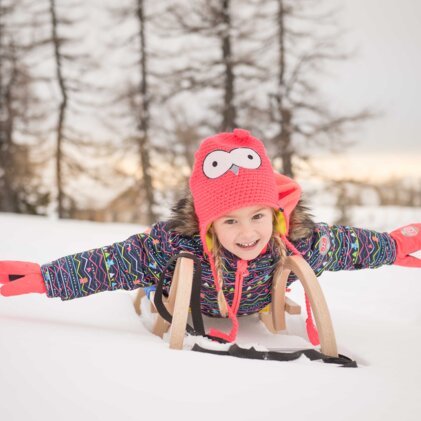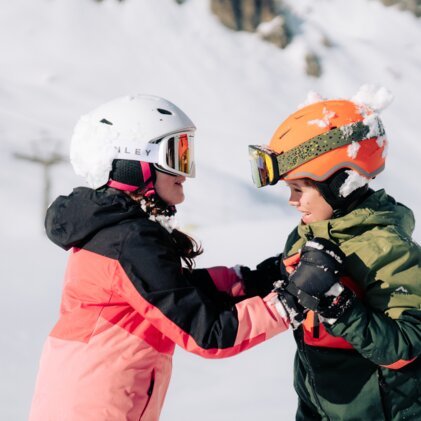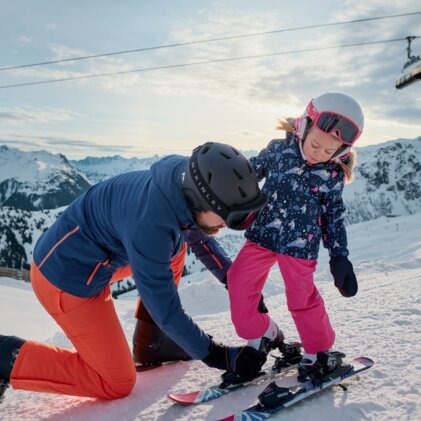
Are your little ones ready to hit the slopes for the first time? How exciting! Before your child attempts their first turns, you probably have a few questions. In addition to general considerations about the best way to get started in winter sports, the question of whether children should learn to ski with or without poles quickly arises. In our article, we have compiled the most important answers and valuable tips for their first turns on the slopes. This will make it easy for them to start skiing!
When to start learning to ski: the ideal age
The good news for ski-loving parents: you're never too young to start skiing! The age at which children are ready depends on their physical development, as they should be able to stand safely on their own two feet. This is usually around the age of three.
The younger they are, the easier it is for them to learn new movements. But just because your child is theoretically old enough to ski does not mean that they want to. If your little one refuses to become the next Marcel Hirscher, it is better to postpone skiing. The desire will come eventually – and until then, you can go sledging together, for example.
Learn at a ski school or teach them yourself?
Even if you are a good skier, a ski school with children's lessons may be a better choice, especially for beginners. The advantages of ski school supervision are:
- professional instruction from experienced ski instructors
- more fun learning in a group with children of the same age
- playful, child-friendly methods
- systematic development of skiing technique
By the way: You should wait a few years before introducing your kids to snowboarding. It is only at the age of six or seven that all muscle groups are developed enough to attempt their first turns on a board.
Should kids start skiing with or without poles?
Ski poles are especially fascinating to many of the little ones on the slopes. After all, mom and dad use two of them! But the answer is clear: It's much easier to get started without poles, which can actually be more of a hindrance at first.
The advantages of learning to ski without poles:
- better balance and posture
- increased concentration on leg work
- less risk of falling due to tangled poles
- easier to get up after a tumble
When should kids start using ski poles?
Ski poles are not useful until children are able to ski safely. The following requirements should be met:
- Your child should be at least 4-5 years old.
- They should be able to snowplough confidently (pizza slice).
- They should be able to make controlled turns in both directions without any problems.
- They should be able to maintain their balance while skiing.
- After a fall, the child can stand up independently.
Our tip: Let your kids decide when to try poles! They will often show interest on their own when they feel confident enough.
The right ski pole length for children
When your child is ready, it is important that the poles are the right length. As with adults, this depends on their height. You can use the following rule of thumb as a guide:
Ski pole length = body height x 0.7
Ski poles are available in five-centimetre increments. If the value is exactly between two lengths, choose the larger one. The following table provides some initial guidance.
Our tip: Check the length using the angle method! Your child should stand upright and turn the pole upside down. When they hold it below the basket and touch the ground with the tip of the handle, their upper and lower arms should form a 90-degree angle.
Table: The optimal ski pole length for kids
| Child’s body height | Ski pole length |
|---|---|
| 85–91 cm | 60 cm |
| 92–98 cm | 65 cm |
| 99–105 cm | 70 cm |
| 106–112 cm | 75 cm |
| 113–119 cm | 80 cm |
| 120–126 cm | 85 cm |
| 127–133 cm | 90 cm |
| 134–140 cm | 95 cm |
| 141–147 cm | 100 cm |
| 148–154 cm | 105 cm |
| 155–161 cm | 110 cm |
First exercises: the best way for kids to learn to ski
Are you and your little one highly motivated to enjoy your first time on the slopes? Perfect! Learning to ski is child's play with the right exercises and tips. These proven methods help beginners stay safe and confident on the slopes:
- Skiing on one leg
Let your child start by sliding on one ski on flat terrain. Just like on a scooter, push off with the other leg to get a feel for moving forward. - Get into position
After a few steps up the hill, help your child get into the correct position: bend the knees and lean forward slightly. And off they go for their first short ride! - Hands on the thighs
Whether it's a snowplough or “schuss”: your child should always keep their hands on their thighs for better balance. - Pizza and chips
Have you successfully mastered the first few metres? Great! Now you need to know how to stop. Show your child how to form the ski tips into a snowplough! Braking and turning are usually easy for little ones to learn with the "pizza slice" and "chips" techniques.
Our tip: The most important part of learning to ski is having fun. So motivate your child with lots of praise!
What equipment do children need to ski?
What's the best way for kids to start enjoying skiing? With the right equipment, of course! It's crucial for safe skiing and fun on the slopes! Make sure you choose high-quality gear that fits perfectly. After all, nothing spoils the mood faster than cold feet or uncomfortable ski boots.
Everything your child needs to ski:
- Skis: the right length for their height
- Ski boots: make sure they fit perfectly
- Ski poles: depending on ability and age
- Ski helmet: mandatory for safe descents
- Ski goggles: for good visibility in all weather conditions
- Ski gloves: important for warm, dry hands
- Ski underwear: made from high-quality materials that wick sweat away from the body
- Ski socks: functional and comfortable for warm feet
- Ski pants: to keep your bottom and legs dry
- Ski jacket: for adequate protection from the elements
- Protective gear: optional for even more safety
Speaking of which: do you know how often you should buy new skis for your children? Find out now in our blog post: When do I need to buy new skis for my children?
Frequently asked questions about learning to ski with or without poles
What mistakes should be avoided when learning to ski?
The most common mistake is using ski poles too early – let your child learn the basics such as snowploughing and the necessary balance without poles first. Always start on flat, well-groomed blue slopes to ensure success. Also remember that children tire very quickly. Short, intensive lessons of no more than 2-3 hours are much more effective. Too much pressure and coercion will only lead to frustration for everyone involved and take the fun out of skiing. Make sure you have the right equipment: Perfectly fitting boots and the right length of skis are essential for fast progress. Our experienced RENTertainers will help you choose the right gear for your child!
Why do you need ski poles for skiing?
Ski poles support skiing for many reasons. They help you keep your balance on the slopes, set the pace when carving and are a good aid for turning. They also help you push off on flat slopes and provide support when resting. For experienced skiers, poles are essential for proper skiing technique and better control.
When should kids not use ski poles?
Children should not use ski poles while holding them rigidly in front of their bodies. This posture leads to a backward lean and an inflexible position. Beginners should also avoid using poles in poor visibility, when tired, or on very steep slopes. As a rule of thumb, poles are more of a hindrance until your child has mastered snowploughing and balance.
How long does it generally take a child to learn to ski?
Progress in skiing is individual and depends on age, motivation and physical development. Most children can ski confidently in a snowplough and make simple turns in about 3 to 4 days. Important: Don't put pressure on your child - have fun!
INTERSPORT Rent tip
The RENTertainer recommends
"They grow up so fast!" This is especially true when it comes to ski equipment. Be prepared for your child to outgrow their ski equipment quickly and for you to need new things at the beginning of each season!
How great that INTERSPORT Rent has a top selection of children's ski gear for rent! Whether skis, poles, boots or helmets, our RENTertainers will help you find the perfect setup for your child.
Related articles
You may also be interested in:
